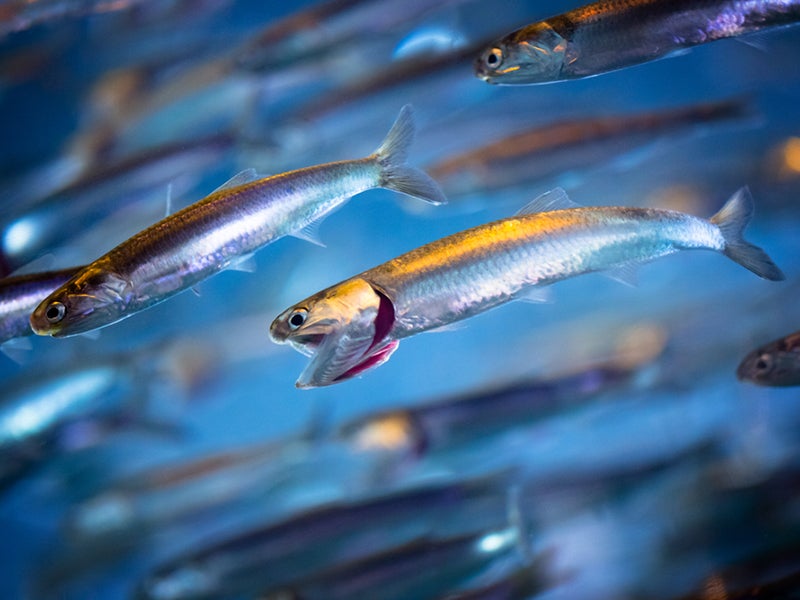Court Rejects Catch Limit for California Anchovy Fishery Following Oceana Lawsuit
Victory
—Ruling finds Fisheries Service disregarded best available science and failed to prevent overfishing
Contact
In response to a lawsuit brought by Oceana, as represented by Earthjustice, a federal judge struck down a decision by the National Marine Fisheries Service (Fisheries Service) to set a 25,000 metric ton (mt) catch level for the central population of northern anchovy for violating the nation’s fishery management law. The court rejected the Service’s reliance on decades-old data to manage this fishery off the California coast. The court found that the government’s annual catch limit was not based on the best scientific information available, and that the Fisheries Service did not adequately consider whether its management prevented overfishing. Instead of basing catch limits on the most recent scientific data showing that the anchovy population had reached a historic low of less than 32,000 mt, the Fisheries Service set the limits based on pre-1990s population estimates assuming a population of more than 733,000 mt.
“The law is clear: the agency can’t sweep inconvenient facts under the rug and rely on a bureaucratic preference to ‘set it and forget it’ for the most ecologically critical fish on the West Coast,” said Andrea Treece, Staff attorney for Earthjustice. “The agency must develop modern, reality-based management measures that reflect the actual status of the anchovy population and ensure that enough of them stay in the ocean to feed pelicans, sea lions, salmon, and other marine predators.”
“This decision holds the Fisheries Service to fundamental standards intended by Congress, which require the government to sustainably manage our nation’s fisheries for the benefit of both fishermen and dependent species,” added Mariel Combs, Pacific Counsel for Oceana.
The decision strikes down the rule currently in place. Now the agency must promulgate new management limits based on the best available science.
“This decision is a huge victory for the ocean’s little fish, and in turn the larger fish and wildlife, that depend upon them,” said Geoff Shester, California campaign director and senior scientist for Oceana. “An abundant anchovy population also supports California’s coastal economy including sport fishing and whale watching. The court delivered an important win for science, marking a turning point that will force fishery managers to safeguard some of the most important fish in the sea.”
Background:
In October 2016, the Fisheries Service set an annual catch limit for the central subpopulation of northern anchovy at 25,000 metric tons (mt), essentially rubber stamping the same limit that had been in place since the year 2000 based on a study from 1991. The 1991 study was based on data from 1964 to 1990, and estimated anchovy biomass at more than 700,000 mt. The agency set this limit in disregard of recently published science and the agency’s own estimates of the 2015 population size, which ranged from 15,000 to 32,000 mt, representing more than a 95 percent decline since 2005. The agency itself admitted that the anchovy had likely declined in the recent past and remained at a low level.
On November 23, 2016 Oceana, represented by Earthjustice, filed a lawsuit in the U.S. District Court for the Northern District of California challenging the proposed 25,000 mt catch limit on the grounds that the federal agency dismissed multiple scientific sources indicating this catch level could exceed the entire anchovy population. Additionally, the Fisheries Service did not demonstrate how it would prevent overfishing of the anchovy population and account for the needs of marine predators that depend on anchovy as prey—key requirements of the nation’s fishery management law.
Northern anchovy are among the most important forage fish for ocean predators off central California, including sea lions, brown pelicans, Chinook salmon, humpback whales, dolphins, shark pups, and sea birds. In recent years, the collapse of anchovy and other forage species like sardines, made worse by excessive fishing, is responsible for mass strandings, deaths, and reproductive failures in a suite of species including brown pelicans, common murres, Brandt’s cormorants, and California sea lions.

Additional Resources
About Earthjustice
Earthjustice is the premier nonprofit environmental law organization. We wield the power of law and the strength of partnership to protect people's health, to preserve magnificent places and wildlife, to advance clean energy, and to combat climate change. We are here because the earth needs a good lawyer.